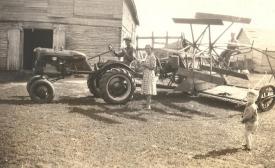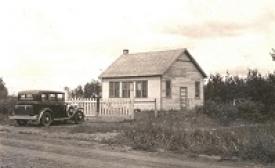Viewpoints
Constants in the context of change
If I were to give a 14-minute TED Talk in our church context before the restructuring assembly for Mennonite Church Canada and its area churches in October, this is the gist of what I would want to communicate. I would like to ask and give an answer to an important question: What is it that is more important for all of us than our current and necessary restructuring?
Readers write: July 3, 2017 issue
Paddling rough waters
Tradition or traditionalism?
How do we know when tradition is helpful or harmful? How do we know when tradition breathes life and hope into the people of God? Or when it becomes a barrier to the leading of the Holy Spirit for our time? This is a critical matter the church must be constantly discerning. Is tradition serving as a propeller or an anchor?
Pies bring a message of encouragement
Tim Sauer is known as the “pie man” because every now and then he shows up at places like the thrift shop or House of Friendship in Kitchener, Ont., with a pie for volunteers or staff. His gifts of pie are meant to bring a message of encouragement, to say, “You’re doing important work.”
Tim’s rhubarb pie
Tim Sauer, who is known as the “pie man,” bakes at least 200 pies a year that he gives away to encourage volunteers and those who work in church-related organizations. This is his recipe for rhubarb pie, a favourite of John Neufeld, executive-director of House of Friendship in Kitchener, Ont.
Tractor and binder
The Voth family in the Steinbach, Manitoba, area on the farm with tractor and binder in the 1940s. August is a busy harvesting time for farmers and gardeners with eyes on the upcoming fall and winter. Farming has changed dramatically in the past decades but remains the backbone to feeding the country and beyond.
Letting all our gifts bloom
“Our deepest fear is not that we are inadequate. Our deepest fear is that we are powerful beyond measure. It is our light, not our darkness, that most frightens us. We ask ourselves, ‘Who am I to be brilliant, gorgeous, talented, fabulous?’ Actually, who are you not to be? You are a child of God. Your playing small does not serve the world.
Muddying the waters on Israeli divestment
Only one person voted against the Mennonite Church Canada Resolution on Palestine and Israel, but we all know the matter is more complex than that.
What would you risk for peace?
In April 2017, more than 1,600 Palestinian political prisoners went on a hunger strike. As I write this article, strikers have refused food and have been drinking only salt water for the last 31 days. They are protesting being held without charge or trial, medical negligence, poor treatment and the lack of family visits.
Readers Write: June 19, 2017 issue
Don’t interrupt me
Holy sexuality
It's better to give
Rabbit Lake church
The Hoffnungsfelder Mennonite Church in Rabbit Lake, Sask., 1938. In 1941, 87 percent of Mennonites were rural dwellers. By 1971, the number crashed to 53 percent and has continued to decline. There has been a massive shift in Mennonite communities toward urbanization, bringing with it new challenges and opportunities.
Wisdom, where art thou? (Pt. 9)
Readers write: June 5, 2017 issue
What does—and doesn’t—define us
Sometimes I think most of our Mennonite lay people, like myself, don’t realize how serious the Future Directions endeavour is that is going on right now. Many think that they are just another bunch of meetings, followed by numerous serious people making long, wordy pronouncements, and then, probably, not much will change.
Spaces of trust
“We aren’t going to lose youth because we haven’t entertained them. We’ll lose them because we haven’t trusted or challenged them.”
I heard this quote from Shane Claiborne at a conference in 2012, and it came back to me a few weeks ago at Mennonite Church Eastern Canada’s annual church gathering during a lunch meeting with leaders of youth.
Microfilm
An idea mixed with passion and solid financial support were the ingredients that combined for a great accomplishment. In 1977 and ’78, young Bill Reimer from Winnipeg set out with elder statesman J.B. Toews to cross North America in a truck and trailer microfilming congregational records.
‘I expected better from you’
Hearing each other
Hearing each other well is essential for being church. This is a delicate theme, because we aren’t doing it well. The effects of distance—both geographical and theological—are being felt within and among our churches.
Reading the responses we collected on our Emerging Voices Initiative (EVI) 2016-17 workshop tour, and reflecting on my experience, I notice two major threads:
Readers write: May 22, 2017 issue
Alberta is an example to us all
Re: “A season of change and a search for vitality,” April 10, page 16.
I would like to commend Mennonite Church Alberta, the Calgary Chinese and Vietnamese Mennonite churches, and Edmonton Vietnamese Mennonite Church.
Hope in a dark-sky world
I grew up with a prairie view of wide open sky and grain fields dotted with cattle. In the living room, however, hung a painting of fishermen hurriedly pulling their boat to shore, racing against turbulent waves and a storm-blackened sky. My father, a life-long farmer, chose the painting for the hope of rain that it portrayed.
Spanish lessons
Walking to my conversational Spanish class, I rehearsed phrases in my head, hoping practice would strengthen my fledgling skills. In spite of my efforts, I knew I would stumble to find and pronounce the right word. Sure enough, in class I attempted to say I had eaten lunch with friends, but instead said I had eaten my friends for lunch. We all chuckled, commiserating about our incompetence.














